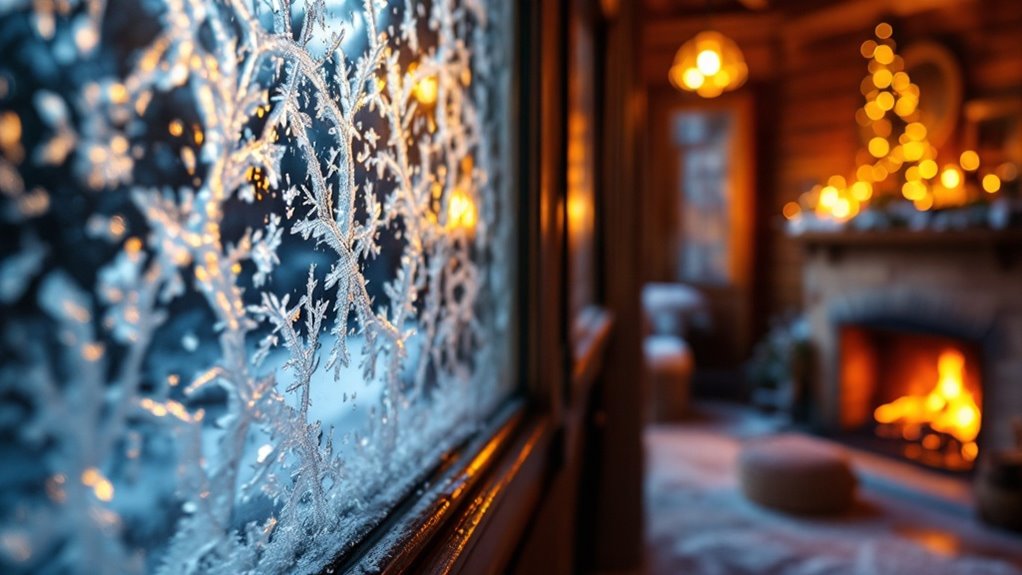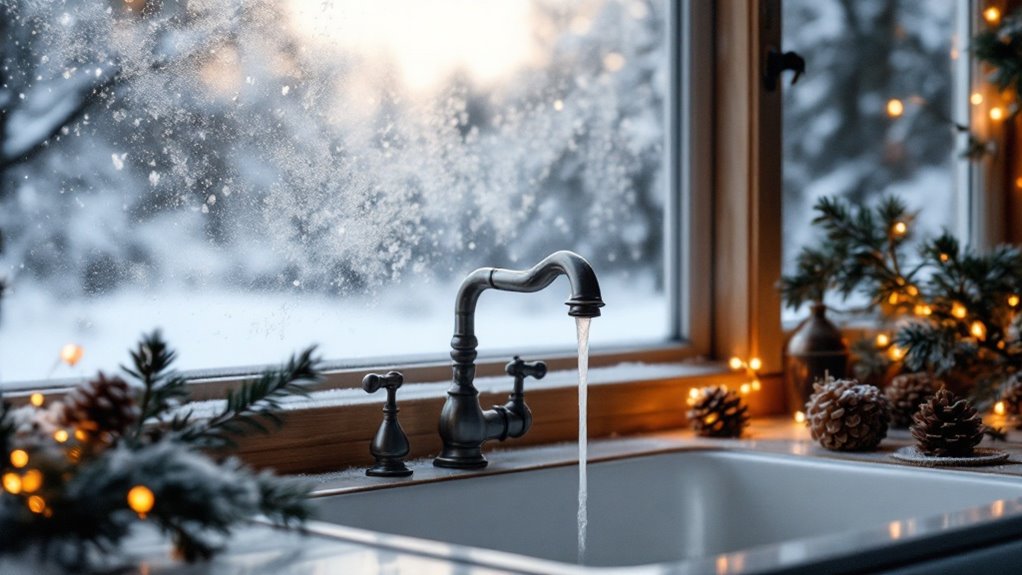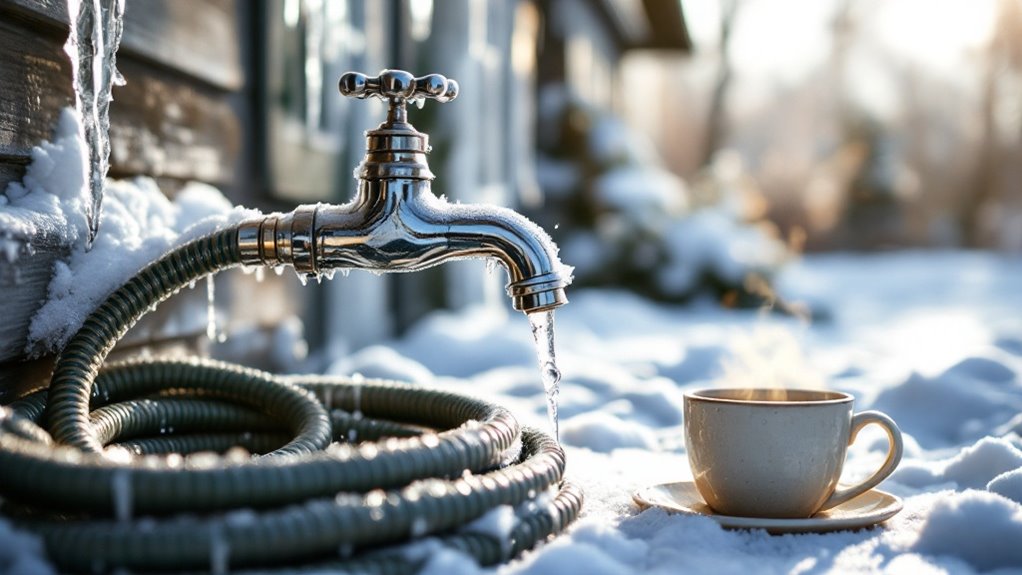As winter approaches, the risk of burst pipes becomes a real concern for homeowners. You might think your plumbing is secure, but even minor oversights can lead to costly damage. By taking a few proactive steps, you can safeguard your home from freezing temperatures. From insulation to temperature control, there are effective strategies that can protect your pipes. Curious about what you can do to keep your plumbing safe this winter?
Key Takeaways
- Insulate exposed pipes and outdoor spigots to prevent freezing and bursting during cold weather.
- Maintain indoor temperatures above 55°F, even when away, to protect plumbing systems.
- Allow faucets connected to unheated areas to drip slowly, reducing pressure buildup in pipes.
- Seal cracks and openings in your home to keep cold air from chilling pipes.
- Regularly inspect plumbing for leaks and vulnerabilities, and schedule professional inspections before winter.
Understand the Risks of Frozen Pipes

As winter approaches and temperatures drop, it’s crucial to understand the risks of frozen pipes. When water inside pipes freezes, it expands, creating pressure that can lead to bursts. These breaks often occur in unheated areas like basements, attics, or exterior walls. You might not notice the problem until the thawing process begins, resulting in water damage that can be costly and time-consuming to repair. Furthermore, the risk increases if you leave your home unattended during cold spells. Knowing these risks helps you take preventive measures early, like keeping your home heated and ensuring proper insulation. By being proactive, you can markedly reduce the chances of facing a burst pipe disaster this winter. Regular inspection of pipes for signs of wear or leaks is essential to help prevent such issues.
Insulate Exposed Pipes
To protect your home from burst pipes, insulating exposed pipes is essential. You’ll want to choose the right materials and use proper installation techniques to guarantee maximum protection. Don’t forget to identify all the areas that need insulation, especially those most vulnerable to the cold. Regular inspections for leaks, corrosion, and blockages can also help in preventing potential issues related to frozen pipes.
Materials for Insulation
When temperatures plummet, insulating exposed pipes becomes crucial to prevent them from bursting. You have several effective materials to choose from, each offering unique benefits. Foam pipe insulation is popular because of its ease of installation and flexibility. It fits snugly around various pipe sizes, providing excellent thermal protection. Another option is fiberglass insulation, which is durable and moisture-resistant, perfect for areas prone to condensation. For a quick solution, you can use insulated tape, wrapping it around pipes to create a barrier against the cold. Finally, heat cables can be installed along pipes to provide additional warmth during extreme temperatures. By selecting the right materials, you’ll greatly reduce the risk of your pipes freezing and bursting this winter. Additionally, regular maintenance practices can greatly reduce common plumbing issues and ensure a more resilient plumbing system against harsh winter conditions.
Proper Installation Techniques
Proper installation techniques are essential for maximizing the effectiveness of pipe insulation and preventing winter-related damage. First, verify that you clean the pipes thoroughly before insulating to promote better adhesion. When applying insulation, make certain it fits snugly around the pipe without gaps, as even small openings can let cold air in. Use high-quality insulation materials designed for your specific climate. Secure the insulation with tape or adhesive to keep it in place and prevent shifting. Pay special attention to joints and elbows, as these areas are prone to freezing. Finally, consider using heat cables for added protection in extremely cold areas. With these techniques, you’ll greatly reduce the risk of burst pipes during winter.
Areas Needing Insulation
Insulating exposed pipes is an essential step in preventing winter damage. When temperatures drop, unprotected pipes are at risk of freezing and bursting. To keep your plumbing safe, focus on these key areas that need insulation:
- Basements: Pipes in unheated basements are particularly vulnerable.
- Crawlspaces: Insulating pipes here protects against cold drafts and freezing.
- Attics: Make sure any pipes running through attics are covered to prevent freezing.
- Outside Walls: Pipes along exterior walls should be insulated to shield them from cold air.
Keep Indoor Temperatures Consistent
To prevent burst pipes this winter, keep your indoor temperatures consistent by maintaining your thermostat settings. You should furthermore insulate any vulnerable areas in your home, like drafty windows and doors. This simple approach can make a big difference in protecting your plumbing.
Maintain Thermostat Settings
While you might be tempted to lower your thermostat to save on heating costs, keeping indoor temperatures consistent is crucial for preventing burst pipes during winter. Fluctuating temperatures can cause pipes to freeze and crack, leading to costly repairs. Here are some tips to maintain your thermostat settings effectively:
- Set your thermostat to a minimum of 55°F, even when you’re away.
- Avoid turning the heat off completely during cold spells.
- Use a programmable thermostat to maintain consistent temperatures.
- Regularly check and change your thermostat’s batteries to guarantee it runs accurately.
Insulate Vulnerable Areas
Maintaining a consistent indoor temperature is only part of the equation; you furthermore need to protect areas where pipes are more susceptible to freezing. Insulating these vulnerable areas can prevent costly damage. Focus on attics, basements, and outside walls where pipes are often located.
Here’s a quick guide to help you identify and insulate vulnerable areas effectively:
| Area to Insulate | Insulation Method |
|---|---|
| Attics | Use fiberglass or foam board |
| Basements | Apply spray foam or blankets |
| Outside Walls | Install pipe sleeves |
| Crawl Spaces | Use rigid foam insulation |
Let Faucets Drip During Extreme Cold

As temperatures plummet, letting your faucets drip can be a simple yet effective way to prevent pipes from bursting. When water flows, it reduces pressure buildup in your plumbing system, minimizing the risk of freeze-related damage. Here are some tips to maximize this strategy:
- Choose the Right Faucets: Focus on faucets connected to unheated areas, like basements or outside walls.
- Drip Both Hot and Cold: Allow both hot and cold water to drip to maintain balanced pressure in the pipes.
- Use a Steady Stream: A steady, thin stream is more effective than a mere drip.
- Monitor Indoor Temperature: Keep your home heated to at least 55°F, even when you’re away.
Seal Cracks and Openings
To further safeguard your plumbing during frigid temperatures, sealing cracks and openings in your home is a crucial step. Cold air can seep in through these gaps, chilling your pipes and increasing the risk of freezing. Start by inspecting areas around windows, doors, and foundation walls. Use caulk or weatherstripping to seal these openings effectively.
Here’s a quick guide to common areas to check:
| Area to Seal | Materials Recommended | Tips |
|---|---|---|
| Windows | Caulk, weatherstripping | Check for drafts |
| Doors | Weatherstripping | Confirm a tight fit |
| Foundation | Foam insulation | Look for cracks or holes |
Disconnect and Drain Outdoor Hoses

One of the simplest yet most effective winterization steps is disconnecting and draining your outdoor hoses. By doing this, you prevent water from freezing inside the hoses, which can lead to cracks and leaks. Here’s how to properly disconnect and drain your hoses:
- Turn off the water supply to the outdoor faucet.
- Disconnect the hose from the faucet, ensuring no water remains.
- Drain the hose by holding it up and allowing any remaining water to flow out.
- Store the hose in a dry place, like a garage or shed, to protect it from harsh winter conditions.
Taking these steps helps maintain your hoses and protects your plumbing from potential damage during the cold months.
Know How to Shut Off Water Supply
Knowing how to shut off your water supply is crucial for preventing burst pipes during winter. First, locate your main shut-off valve, usually found near the water meter or where the main line enters your home. Turn the valve clockwise to shut off the water, ensuring you have complete control in case of emergencies. It’s a good idea to familiarize yourself with this process before a freeze hits. If you have outdoor spigots, consider installing frost-proof faucets or insulating them to further minimize risks. Remember to check if your water heater has a shut-off valve as well. Being prepared can save you from costly repairs and headaches if the temperature drops unexpectedly.
Conclusion
By taking these winterization steps, you can safeguard your home against the icy grip of winter. Think of your pipes as delicate veins running through your house; if they freeze, your home can suffer serious damage. Insulating, maintaining temperatures, and sealing gaps are like wrapping your pipes in a warm blanket. Don’t wait until it’s too late—act now to prevent burst pipes and guarantee your plumbing flows smoothly all winter long.
